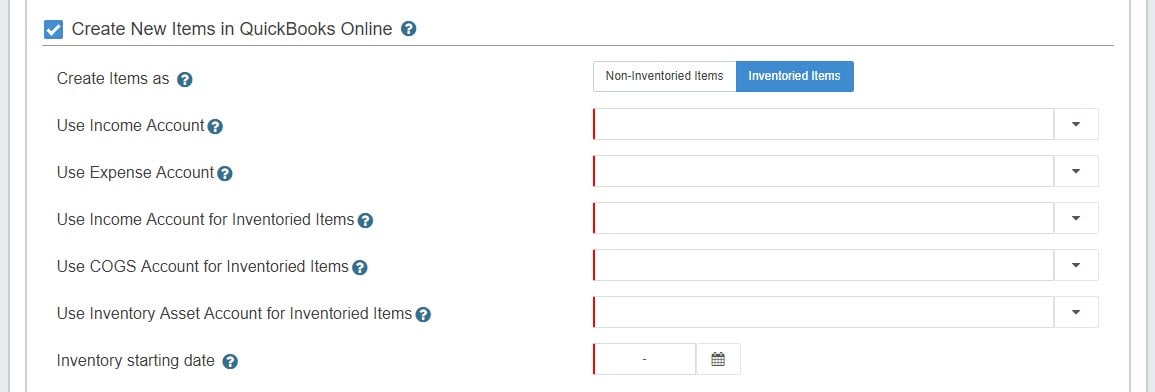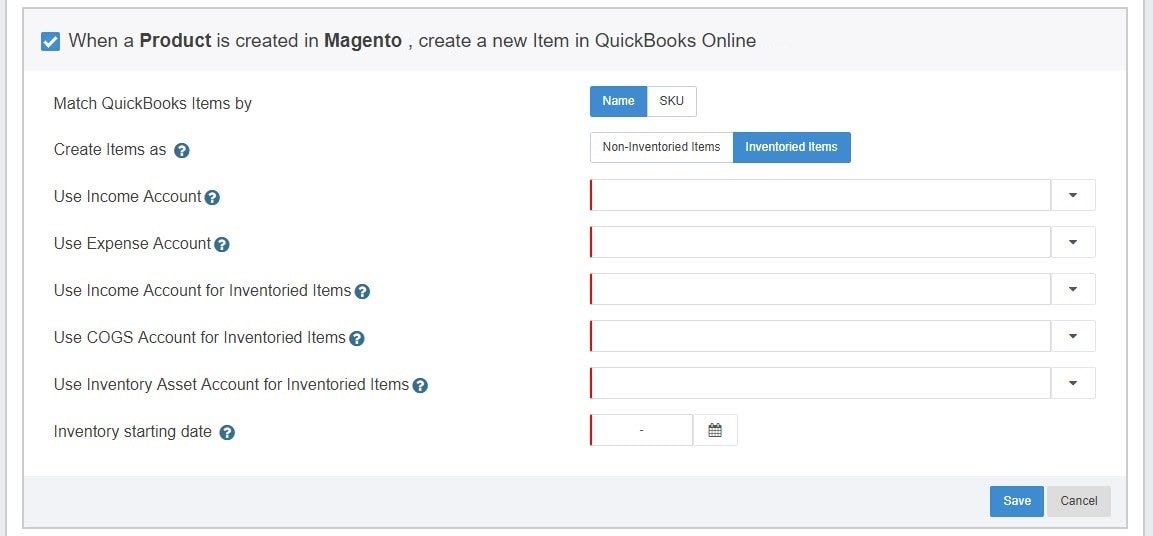Integrate Magento to QuickBooks Online with OneSaas
by Intuit• Updated 3 weeks ago
Learn how to integrate Magento into QuickBooks Online.
With QuickBooks Connector (OneSaas), you're able to set up your complete integration between Magento and QuickBooks Online within minutes using our simple setup process. Below is a step-by-step walkthrough, highlighting some useful key points throughout the process.
Step 1: Connect your app to QuickBooks Connector
The configuration process described below is for a standard integration between Magento and QuickBooks Online. If you are also connecting a third app, then you'll have to configure this as you go through the setup process.
1. You’ll be presented with three workflows, which are all optional. In this walkthrough, these three workflows will be selected to demonstrate the full capabilities of the setup process.
- Sales from Magento to be sent into QuickBooks Online.
- Products from Magento to be sent into QuickBooks Online.
- If you have stock turned on in QuickBooks Online, QuickBooks Connector can read this information, and update Magento.
2. Start the configuration process by selecting the first workflow to sync Magento orders into QuickBooks Online.

Once you've selected the first option to create orders in your QuickBooks Online, you'll be asked to:
- Select the Magento order statuses from which the app will retrieve sales to sync into QuickBooks Online. Depending on the nature of your business, you may want to also sync sales in the Pending or other statuses.
- Select how Magento orders will appear in your accounting system. In the case of QuickBooks Online, choose if you want your Magento orders to be sent to QuickBooks Online as Sale Invoice or Sales Receipts. Select the appropriate option for your business.
3. Select Default Product and Advanced Options.
These options give you greater control over how sales appear in your accounting system. If you are unsure, then you can leave this section blank for now and come back at a later date to re-configure them.
- Order number prefix - The prefix you input here is added to all your orders retrieved from this Magento account. For example, if you have order '1234' in Magento and you add the prefix 'Mag-' in the configuration, your order will be retrieved into QuickBooks Connector with the order number 'Mag-1234' and sent to QuickBooks Online accordingly. This prefix can be configured separately for multiple Magento connections, to make it easier to identify the source of each invoice in QuickBooks Online.
- Use shipping item - You may be charging your customers extra shipping charges on your sales. If this occurs, the integration can allow you to specify a dedicated "Item" to assign these shipping charges. This will allow you to easily track any revenue generated from shipping charges. Learn more on how to use shipping products in QuickBooks Connector.
- Discount product - Similar to the shipping item option above, you can specify a dedicated discount 'Item' so you can track your discounts on sales.
- Original Customer / Customer's Organisation / Generic online sale customer - Most accounting systems require a customer record to be specified when a sales invoice is created. This particular option allows you to choose the nature of the customer record that is being created. The default option is Original Customer; however, if your Magento customers specify a company name and you prefer to have that appear within your Accounting system instead, then you can opt for the Customer's Organisation option.
Alternatively, if you do not want any customer records to be created within your Accounting system at all, you can select the Generic Online Sale Customer option. This means all sales will be synced to your Accounting system against a generic "Magento" customer record.
- Automatic Invoice Numbers - This option allows you to disregard the Magento order number completely, and use the sequential numbering convention within your accounting system.
- Assign Sales to Class / Assign Sales to Location - These two options allow you to choose a default class or location within your QuickBooks Online system. This is an option unique to QuickBooks Online, and only if you have set up classes or locations within your QuickBooks company file.
If you have any questions, reach out to our support team for help at any time.
4. You'll be taken to the tax configuration page. Here, for each tax created/defined in your Magento, you must select its corresponding sales tax in your Accounting system. Learn more about tax configuration.

5. In order for sales to properly integrate with your accounting system, you'll need to have all of your Magento items set up with unique SKUs.
Note: With QuickBooks Online integrations, we have two product matching options:
- Name: We match the product's SKU field from Magento to the product's NAME field in QuickBooks Online
- SKU: We match the product's SKU field from Magento to the product's SKU field in QuickBooks Online
6. If you have no items set up within your accounting system yet, or if you would like QuickBooks Connector to read Magento items and create them within your accounting system, you can enable the following option.

On the Items Settings configuration page, you'll have to select the Income and Expense Accounts to be used for Inventoried and Non-Inventoried items. Learn more about the integration of your products in QuickBooks Connector.
7. Payments configuration settings will allow you to select whether you want payment data from Magento to be registered against your sales within your accounting system.
If you want to map different payment methods to different clearing accounts, select Map Individual Payment Methods.
Make sure you select Save once you are happy with your changes.
Note: If you are unsure of which clearing accounts to use, please consult with your accountant.
Learn more about configuring Tax with QuickBooks Connector.
8. The next workflow option will allow QuickBooks Connector to read all of your Magento items and create them into your accounting system. Some users prefer to only have items that are used in actual sales to be created (which is covered above), while other users prefer to take all Magento items and send them through instead.
Make sure you select Save once you are happy with your changes.
Note: If you want different products to have different income/expense accounts, this will have to be set up within your accounting system after the items are created by the app.

9. If you would like to send stock level data from your QuickBooks Online to your Magento products, you can simply select the final workflow, then select Save.
Note: Stock Levels are not available to configure with QuickBooks Online France.
Important: This option should only be enabled if you have stock levels set up in QuickBooks Online prior to the integration. Otherwise, you will risk wiping out your Magento stock levels. Learn more about our stock control process.
Once you are finished with configuring your integration workflow settings, you can proceed with setting up your sync settings. This can be found under the Sync tab.
The Integration Starting Date setting specifies a filter against your Magento order date. This means that any orders dated before the specified date will not sync.
Once you have agreed to the QuickBooks Connector user terms and conditions, you can then turn on the automated hourly sync.
More like this
- Stock control between e-commerce and QuickBooks Online with OneSaasby QuickBooks
- Integrate Squarespace and QuickBooks Online using OneSaasby QuickBooks
- Integrate Shopify with your accounting system using the Shopify app store and OneSaasby QuickBooks
- Configure tax with QuickBooks Connector (OneSaas)by QuickBooks